Long-Form vs Short-Form Content: Which One to Choose?
From the point you start implementing your content marketing strategy, you face an important decision – how long your content should be.
On the one hand, shorter content is easier to digest. But on the other hand, you cannot do a deep dive with an article of that size.
So when is it better to do short-form content, and when shall you choose the long-form one?
Our guide today will have these answers for you.
What is Long-Form Content?
Long-form content is anything that is usually longer than 1,000 to 1,200 words and covers a specific topic in-depth. Thanks to the granularity of information in it, long-form content attracts readers whose goal is to dive deep into the details and obtain comprehensive information about that particular topic.
The popularity of long-form content is growing rapidly, with average blog posts taking 25% longer to write in 2016 when compared to 2015. As a result, you get a chance to engage your audience with well-made deep-dive articles and guides and increase your brand’s authority in your industry.
Now let’s understand it better by going over the types of long-form content and its examples.
Long-form content examples
As we mentioned already, long-form content works best for discussing the details and intricacies of your topic. It fits with informational and educational content best, as readers looking to learn something new will prefer the piece that covers it in more detail.
Some of the common types of long-form pieces include:
- Evergreen articles and pages.
- Tutorials and how-to articles.
- eBooks and Whitepapers.
- Podcasts and webinars.
- Case studies.
Here is what an example of long-form content looks like.
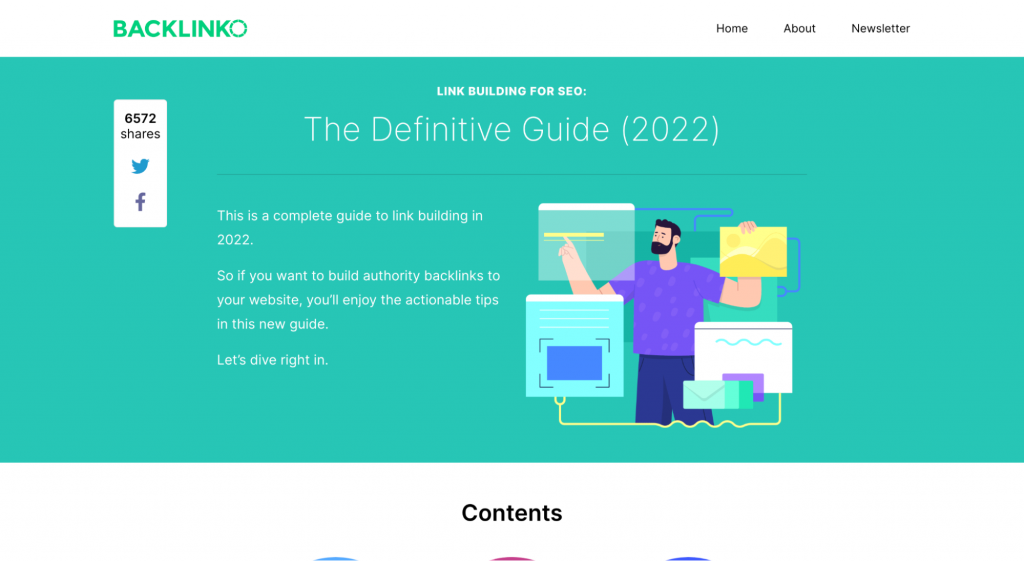
The article here is the comprehensive guide on link building by Backlinko, which is more than 4,500 words long. The website has divided its article into eight chapters that touch upon every aspect of the link-building process in great detail, with visual examples and guides on using popular SEO tools.
We at Digital Marketers World are fond of long-form content, too, as our blog consists of educational materials on digital marketing that dive deep into the topic and provide readers with lots of details. Here is an example of it.

Here we have our guide on generating high-quality leads with a length of 4,600 words. We chose the long-form content format here to teach our readers everything about the types of leads, how to find them, what the funnel looks like, and other aspects.
This was all for the introduction to long-form content; now, let’s understand what its counterpart is about.
What is Short-Form Content?
Short-form content, as the name implies, is anything below the 1,000 to the 1,200-word threshold that defines the long-form content size.
This type does not go deep into the subject and cover the details and intricacies. Instead, you can give an overview of the topic that is lightweight and does not take too much time or attention from your readers. Therefore, short-from content is much easier to skim and consume.
To get a better grasp on this type of content marketing, let us show you some examples of short-form content too.
Short-form content examples
Short-form content works best for cases when you want to inform the readers about something important and need to quickly catch their attention and convey your information instead of educating them on the topic with content that dives deep into the details,
The typical cases for short-form pieces include:
- Short blog posts and short-form articles.
- Short videos.
- Social media posts (e.g., tweets, Linkedin posts, etc.).
- Listicles.
- Infographics, etc.
Let’s look at short-form content with the example of a social media post.

The post on the photo-sharing social media network Instagram here belongs to the hospitality service Airbnb. They have made a short caption for the image of Lake Superior that they posted, aiming to increase the interest of their users in booking an Airbnb property near the lake.
Here is another short-form Instagram post.
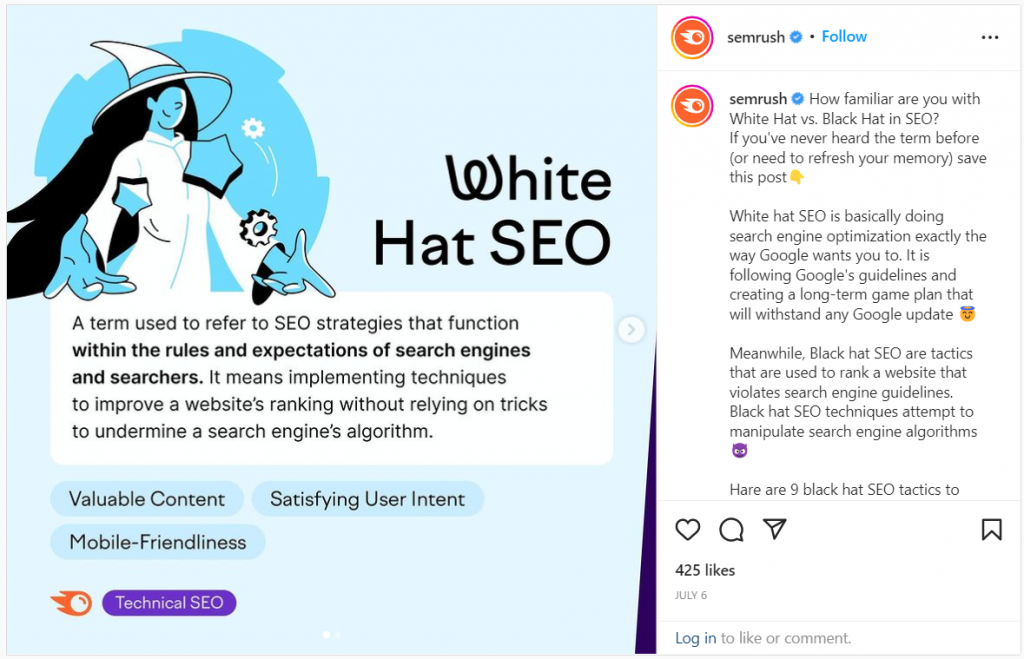
This one belongs to the SEO and digital marketing tool Semrush. The company talks about the difference between black hat and white hat SEO, explains the cons of using black hat tactics, and encourages readers to turn to white hat instead.
Now that you know what each content type is about, you might wonder if it is better to make long-form content or short-form one. Let’s find an answer to it.
Does Content Length Matter?
The short answer is yes, content length matters, and it matters a lot.
So is making shorter pieces better? Or should you opt-in for longer ones? Well, it depends on the format and what you want to achieve.
Ads, social posts, and everything that aims to catch the users’ attention needs to be short and concise. Educational content, however, needs to be long enough to cover all the crucial aspects of the topic.
There is a general shift towards making content shorter, as Google has started testing the Quick Read algorithm, placing “5-minute read” labels on search results. So in the future, content teams might consider fitting everything into the 5-minute size.
Another reason to choose one type of content over another is its benefits and drawbacks, so let us explore them as well.
Key Benefits of Long-Form Content
We start with long-form content. Here is an overview of the advantages you can enjoy with this type of content.
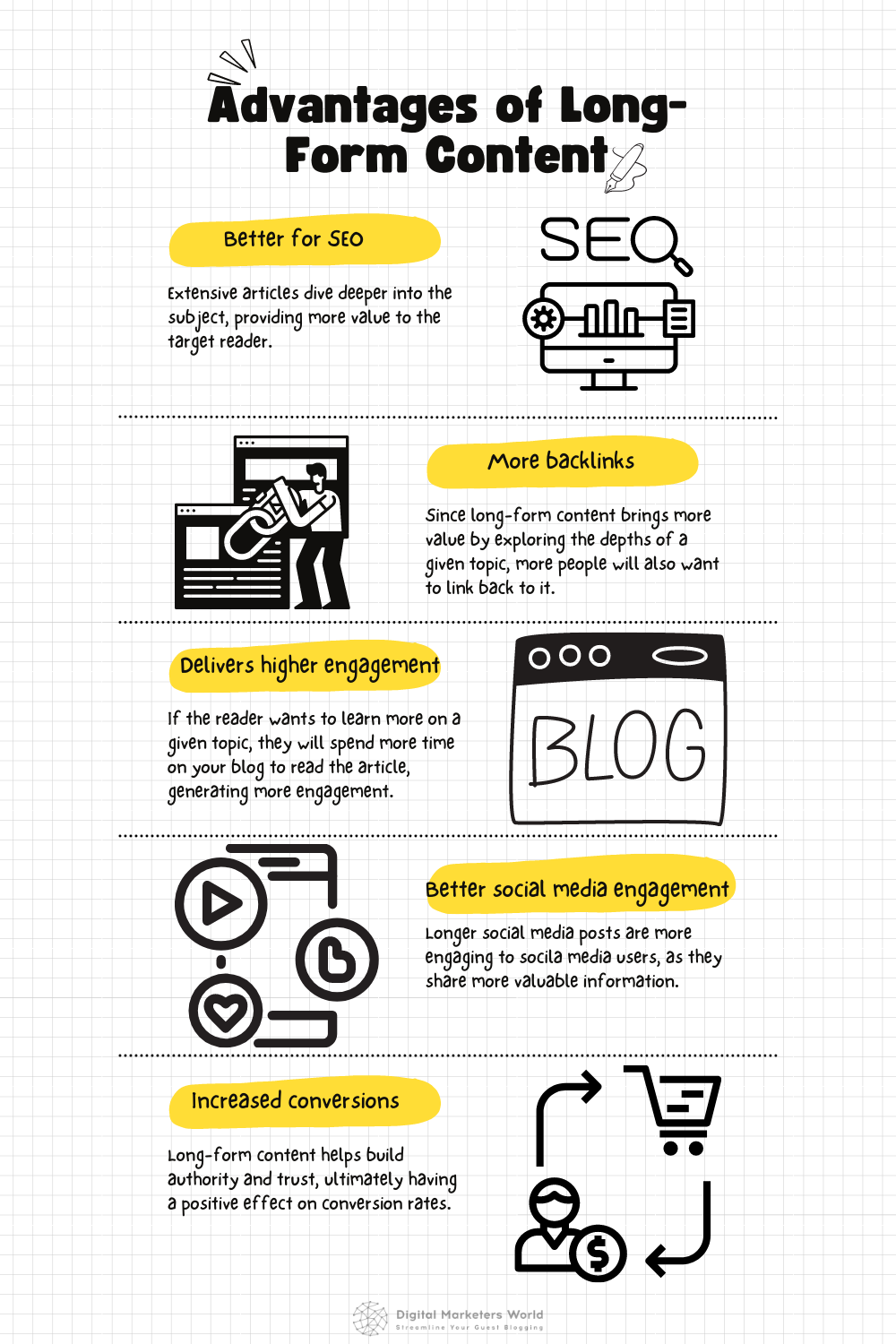
Now, let’s see what each one is about.
Benefit #1: Long-form content tends to be better for SEO
Long-form content can contribute to your search engine optimization (SEO) efforts and drive organic traffic. The reason is that extensive articles tend to get better rankings based on their respective keywords.
According to 2012 research that serpIQ conducted on more than 20,000 keywords, there was a positive correlation between the length of the content and its average position on the search engine result page (SERP).
Here is what the correlation chart looked like.
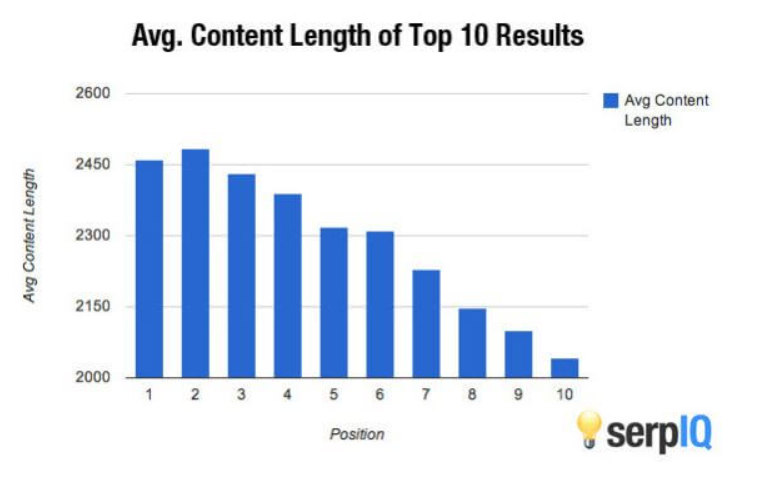
As we can see, posts and articles longer than 2,500 words tend to get the first two spots in the SERP for their keyword. The 2,000-word articles, on the other hand, were barely getting the 10th spot.
One of the reasons behind this correlation is that people looking for informative content will likely prefer the article that explains the topic the best and covers most of the questions they had about it.
What usually happens is people open several articles from the search results, skimming them, choosing the most comprehensive one among them, and closing the rest. The result is that the bounce rate increases for the pages they close and decreases for the article they choose to read.
Therefore, long and comprehensive guides with several thousand words get the most attention.
Benefit #2: It generally earns more backlinks
Another SEO-related benefit we want to point out for long-form content is its ability to earn backlinks.
In general, the longer content is, the more backlinks it will earn. This is a correlation that SEO and digital marketing SaaS service Ahrefs found in one of the researches they conducted on SEO.
Here is the chart that demonstrates the relation between article length and the number of referring domains.
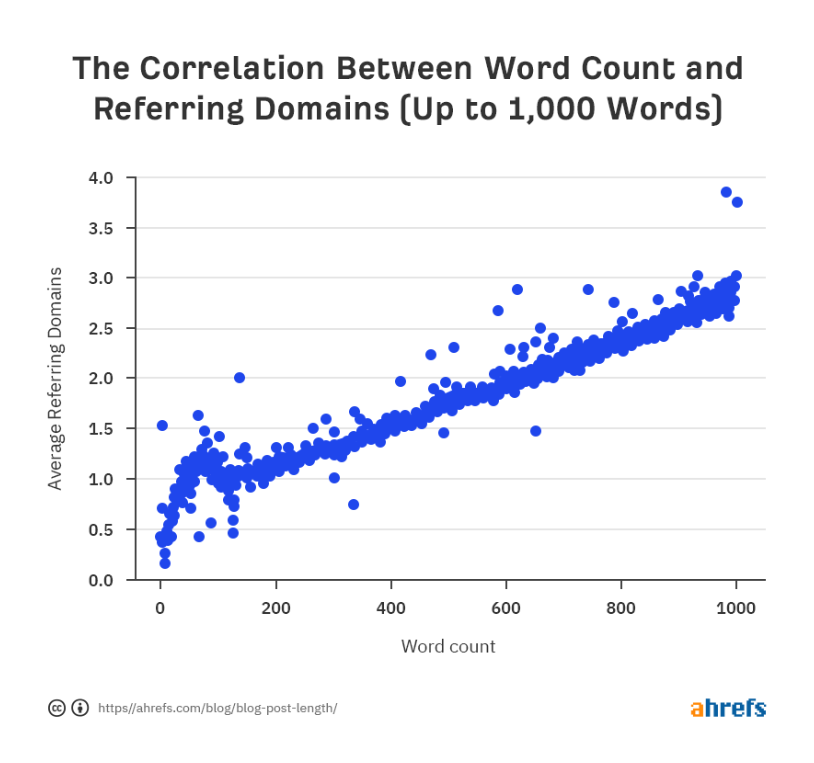
From the data that Ahrefs analyzed, we can see that any content with an average length of 1,000 words or over can get around two times more referring domains than the short ones with 500 or fewer words.
Benefit #3: Keeps readers more engaged
While short-form content is great at catching your attention and quickly passing a piece of information, they are not that great when it comes to engaging the reader.
So, to keep your readers longer on your website, you should consider long-form content instead as, according to a paper by Pew Research, people will spend 200% more time on articles that are longer than 1,000 words compared to short-form ones.
One of the reasons behind the relationship between engagement and content length is that people will trust your brand more if they read comprehensive and highly detailed content on your website, as it demonstrates that your brand is an authority on the topic.
Benefit #4: It boosts social media engagement
Another benefit of long-form content is that social media users will engage with it better than with short-form content.This assertion comes from comprehensive research by Moz that analyzes 1 million articles and their performance. Here is what they have found.

We can clearly see a clear relationship between the length of the content and the number of shares it generates on social media (based on SMM tool metrics like BuzzSumo). In fact, content with a length of over 3,000 words can get almost two times more social shares than smaller articles with less than 1,000 words.
Benefit #5: Has higher conversion rates
Finally, long-form content can help you increase your conversion rate.
We talk about consistently posting long-form content on your blog. This kind of content will help you build trust and authority for your brand among your target audience, thus increasing the likelihood of them becoming your paid customers.
Apart from the blog posts, you can consider adding long-form content to your service and landing pages. In fact, Conversion Rate Experts and Crazy Egg performed an experiment where they increased the landing page length by 20x and saw a significant increase in the conversion rate (around 30%).
To conclude, thanks to its ability to engage and create trust, long-form content can be a highly-valuable part of your content marketing strategy.
But long-form content is not perfect, and there are a couple of downsides you should be aware of too.
Key Disadvantages of Long-Form-Content
Just like any tactic or type of deliverable in digital marketing, long-form content also has. Now let’s see what they are.
Disadvantage #1: Longer creation process
Naturally, creating a piece of content with several thousand words will not be quick. Apart from the time it takes to write the text itself, long-form content writers also spend considerable time doing prior research, gathering statistical data and references, and performing fact-checking.
All of this results in your content team spending many days on a long-form article. At Digital Marketers World, for instance, it takes an entire week to research, write, edit, proofread, and publish a single long-form article.
Disadvantage #2: Mobile friendliness can be an issue
The world has gone mobile (mobile devices were responsible for 80% of global traffic in 2019), so it’s essential to invest in mobile-friendly content like never before.
Unfortunately, long-form content is lacking in this area, as it is highly inconvenient for mobile users to read articles that are several thousand words in length. The reasons are long paragraphs that go off the screen, images that are not optimized for mobile, long scrolling, and others.
As we can see, long-form content is great, but it is not without downsides too. However, if you manage to mitigate them, you can benefit from this type of content without facing the risks we listed above.
Now let’s move on to short-form content and explore its benefits and downsides.
Key Benefits of Short-Form Content
Short-from content is full of advantages too. Here are the main pros you can get when choosing this type of content.
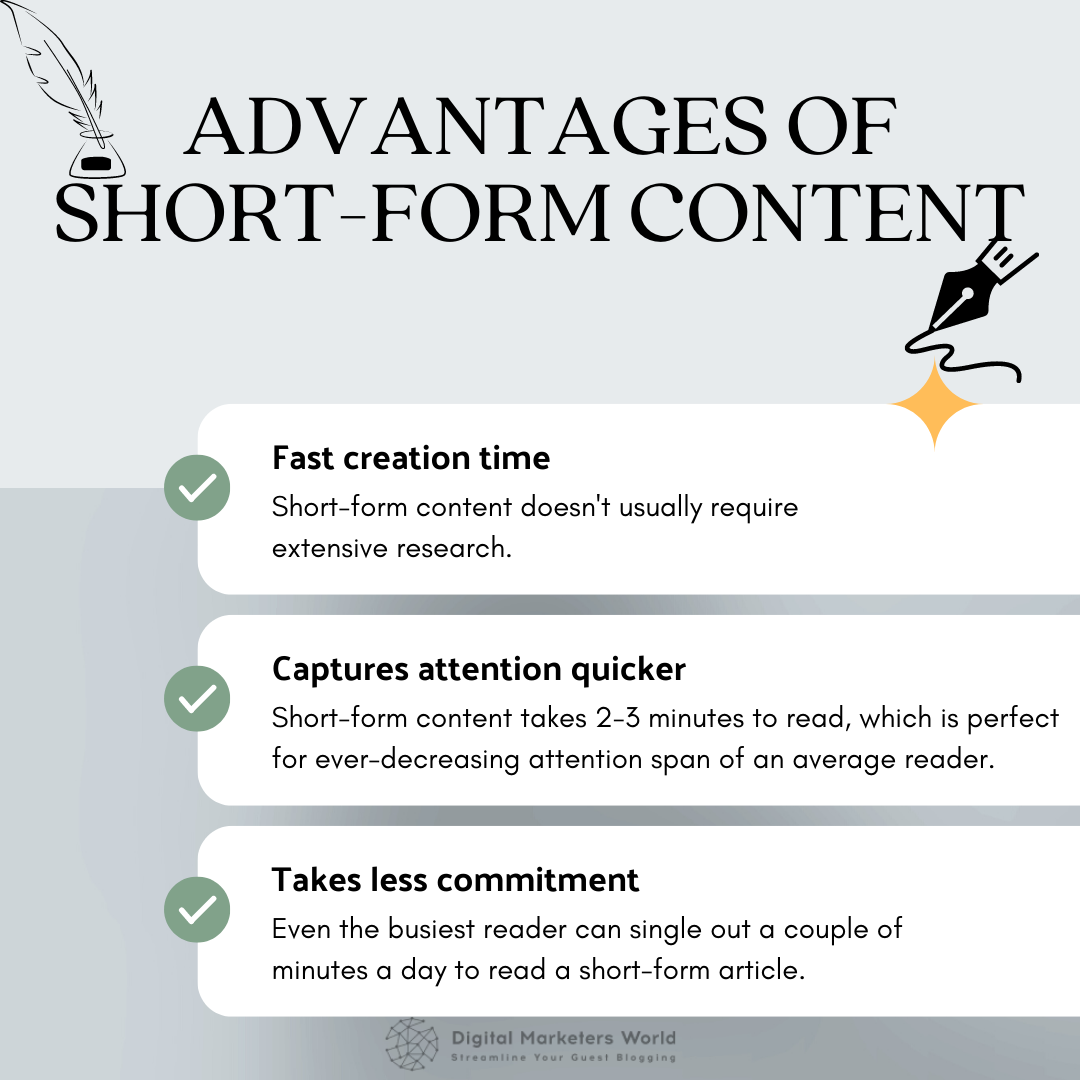
Now let’s dig into the details of each one.
Benefit #1: Faster creation time
Compared to its long-form counterpart, short-form content is much quicker to produce. There are two reasons behind this:
- Short-form content is, well, short. It is usually several times smaller in size than long-form content, meaning that your content creators will spend significantly less time writing the text.
- Short-form content is not detail-oriented. Considering its size and purpose (to catch attention and convey a message), short-form content rarely includes any intricate information and low-level details. It means that your content writer will not have to spend hours performing research and fact-checking.
Thanks to all of this, you can churn out short-form content in mere hours, compared to the days for the long-form one.
Benefit #2: Captures attention quicker
The modern digital world is a constant fight for the ever-shrinking attention (it dipped from 15 seconds to just 8 between 2000-2015) of Internet users.
With only several seconds of attention at your disposal, you cannot afford to serve your users long and hard-to-read texts, as they will quickly get bored and move away.
This is where short-form content saves the day, as it is meant to be minuscule in size while containing catchy texts that can quickly grab the reader’s attention.
Benefit #3: Takes less commitment
The third benefit of short-form content is about the time that your users will spend reading your content.
Time is a valuable resource for everyone, and people will likely single out 2-3 minutes of their time (the equivalent of around 400 words) to consume your content compared to more than 10 minutes (about 1,300 words).
As we can see, using short-form content is a beneficial content marketing strategy. However, as with the previous type, it comes with its own cons too.
Key Disadvantages of Short-Form Content
Although keeping everything short and concise is beneficial in terms of catching your users’ attention, the small size of it creates a couple of issues for you too. Here are two of the main ones.
Disadvantage #1: Lacks depth
If you have a limit of only a couple of hundred words, it is unlikely that you will be able to dig deep into your topic and provide your readers with comprehensive details, research results, etc. Your content will usually barely scratch the surface and only briefly talk about the main points of your topic.
Therefore, short-form content cannot build trust and authority for your brand in the eyes of the reader as much as long-form ultimate guides and eBooks can.
Disadvantage #2: Fewer SEO benefits
Small size content is not beneficial for you in terms of search engine optimization performance either.
As we saw in the two research results in the long-form content benefits section, short content gets you worse search engine rankings and fewer referring domains.
Another disadvantage of short-form content in this area is that you cannot place many keywords in it, considering its size limit. Therefore, you will not be able to end up with a keyword-rich article that the search engine bots will deem worthy of better rankings.
To sum up, short-form content is a great choice for sharing small bits of information with your users, but you should not rely on it for making educational pieces and improving your SEO.
Now let’s move on to the tips for creating both types of content.
3 Tips on How to Create Long-Form Content
The workflow and process of creating long-form content might seem hard at first. But the more pieces of content you finish and publish, the easier it becomes. To make it even easier for you, we have gathered a couple of handy tips you can use in your content creation process.
Tip #1: Separate your content into different sections
Having text with a word count of a couple of thousand can easily hurt readability. To counter this, you can structure your article into sections by using headings and subheadings like H2, H3, and H4 tags and separate text into paragraphs that are only several lines long.
The great news is that nearly all CMS and word processing tools (e.g., HubSpot) have the necessary features for you to do this structuring.
Tip #2: Add visuals
Adding visual content is another way to increase the readability of your long-form content and break long patches of text into sections.
Visual content also helps your readers consume the information better as they remember 80% of the visuals and only 20% of the text.
Tip #3: Leverage white space
Taking advantage of white space to improve user experience is a key element of UI/UX design. But it does not limit only to interfaces, as you can use whitespace in articles to improve readability too.
In particular, you can use bullet points when listing several items and play with the line spacing to make it easier for your readers to switch from one line of text to another.
Now let’s move on to the tips for short-form content.
3 Tips on How to Create Short-Form Content
Just like its counterpart, short-form content is not too hard to produce either, especially when you have some experience and are following the best practices, including these three.
Tip #1: Get to the point
You will be facing a short attention span of your reader. So you cannot afford to increase the length of your content and use fancy sentences. On the contrary, you should keep everything concise and get to the point as quickly as possible.
Tip #2: Include visuals
Visuals work great with short-form content too. In this case, they are a great tool for catching your readers’ attention with their compelling design and copy.
Thus, consider adding visual elements that complement the information in your content, such as infographics or relevant photos or illustrations.
Tip #3: Give your readers the opportunity to dive deeper
This case is about the combination of short-form and long-form content when you use the shorter one to catch the reader’s attention and include a link to the long one for them to read and build trust in your brand.
As we have shared the best practices for long and short-form content, we can move on to understanding which one to choose.
Long-Form Content vs. Short-Form Content: Choosing Between Them
Both long-form content and short-form content are great solutions if you are using them in the right place. Your choice between these two different types of content will depend on these four factors.
Factor #1: The marketing channel
Each marketing channel has its preference for content size. If you plan to fill your B2B professional blog with content, then long-form content is better. However, if you consider making social media posts, then you should consider short pieces of text.
Factor #2: Your business goals
Each type of content serves a different business goal. Short-form content is great for increasing reach and awareness, while long-form content can help build trust and authority.
Factor #3: Your audience
Your audience might have a preference for the length of content too. If they are professionals interested in educational content, then long-form is best for them. If they want to get news or entertainment, you should consider short-form instead.
Factor #4: Your competitors
Finally, you should analyze your competition and see if they use short-form or long-form content to reach out to their audience.
Now Over to You
Comparing short-form content to long-form one is similar to comparing apples with oranges, as both types are great if you use them for the right purpose. Short-form is effective content for awareness campaigns, while long-form is better for building trust among your audience.
There are many more guides and comparisons on the topic of digital marketing in our blog. Go check them out!

Sona Kalantaryan is a senior digital marketer with a creative past. Big fan of high cinema and well-optimized landing pages. She authors guides by sharing the best practices and does it the right way!
